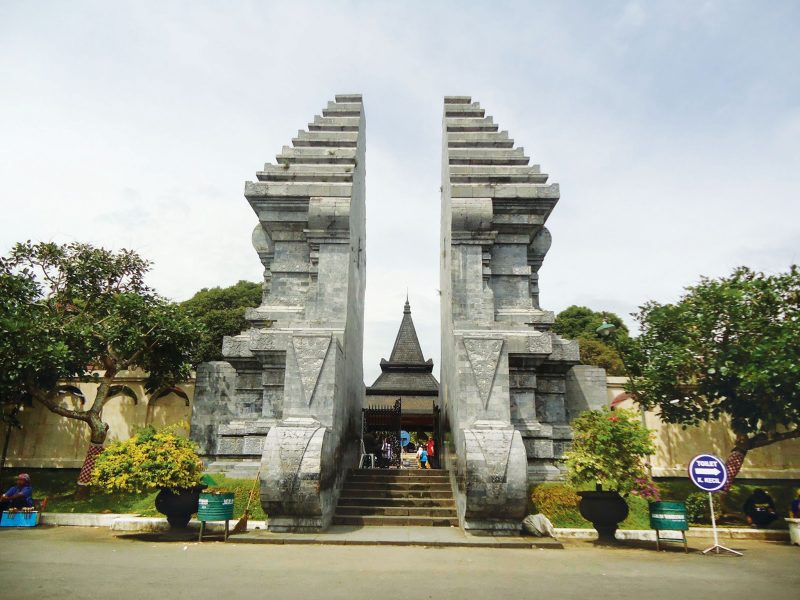There’s much that’s curious about Blitar. Harmonious yet discordant, mainly subtle, then abruptly blunt. Certainly different. Well worth sampling.
It’s not so big; with just 140,000 residents Blitar ranks number eight in the hierarchy of East Java’s cities. That doesn’t always mean less traffic – smaller towns are often more cramped and crowded. But through a measure of planning wisdom decades past, the streets are mainly wide and straight. Later administrations added one-way traffic. All it needs now are police cameras to snare the hoons who believe space needs speed.
Fortunately, they are few (jerks and cops) so it’s possible to cross Jalan Merdeka at almost any point without getting snared for jaywalking or skittled by feral Hondas.
Where to stay? This is not a puff for the grand 19th century Tugu Hotel on this same street, but even if you camp elsewhere take a peek – staff members are accommodating and there are cheaper rooms tucked away. The central pavilion, where prices start at a million rupiah plus plus, is grand without being majestic. The restorers have been gentle. There’s a suite devoted to founding President Sukarno, as is the whole town.
When the 1945 Proclamator of Indonesia’s Independence died of kidney failure in 1970 General Suharto, who’d ousted him five years earlier, had a grave problem. He feared a Sukarno headstone in Jakarta would become a rallying point for the resentful angered by the 1965 military takeover and purge of communists.
So, the remains of the 69-year old were sent 750 kilometres southeast to Blitar where Sukarno had lived as a child with his grandparents. Suharto’s fears were well grounded; neither distance nor time has dissuaded pilgrims. The founder’s tomb has become a national shrine and a huge earner for the city.
Well over half the archipelago’s 260 million citizens were born after Sukarno died yet the nostalgia industry seems unquenchable, with busses often delivering crowds keen to commemorate the father
of the Republic and his supposed glory times. On special days, like 21 June, the anniversary of his death, the pride is palpable.
In this intoxicating environment the unwelcome voices are sober historians reminding that although Sukarno was a towering revolutionary he was a midget manager of the economy. He shunned the West, seized foreign-owned businesses and courted the Reds.
He had nine known wives; the 132-metre Russian-realism Monas (Monumen Nasional) pillar in Central Jakarta is known as ‘Sukarno’s last erection’. It was supposed to rival the Eiffel Tower.
Unfortunately, the Blitar mausoleum is almost as kitsch as the back-scratchers and other trashy souvenirs sold outside the gates. More authentic is the house where Sukarno lived.
The gravesite’s slab design is weird, for the city and its surrounds are full of creatives. One village makes kendang jimbe, the goblet-shaped hand drums, and exports to China.
There are potters, carvers, musicians and painters, descendants of the artisans who over 250 years built the Penataran Shiva Temple complex. This is 12 kilometres out of town on the lower slopes of Mount Kelud, 1,731 metres and last active in 2014.
The reliefs, many showing episodes from the Ramayana epic and scenes of daily life, are marvelously rich and superbly executed. Some are quirky and playful. All are spellbinding, the past speaking to the present with clarity. This is not manicured, hyper-commercialised Borobudur, which is not to demean the mighty Central Java Buddhist temple built four centuries earlier. But smaller Penataran is so much easier to wander and ponder.
However, getting there can be tricky. Blitar doesn’t have taxis, public transport or an airport. The city is accessible by rail – five hours from Yogya, two from Malang. Then it’s a stroll from station to centre – though not beyond. There are becak (pedicabs) but the old peddlers keep to city limits.
There are only four hotels; two rent bicycles. The roads are mainly flat and there’s much to marvel. Foreigners still turn heads so Bali-style rip-offs are rare. Expect to be recruited for selfies.
Blitar can be raw. On Jalan Merdeka a door opens onto cages with four long-tailed macaques. The friendly owner sluices their droppings into the street. Adjacent is a shop packed with fireworks waiting for one fag to blow up the block. Down the road is the freshest butchery in the region. The animals are slaughtered in a back room and the quivering bloody meat barrowed to the shop front.
A street behind is the lush and lovely flower market squeezed between a narrow lane and the railway line. It’s not signposted or promoted. It should be.
Diners at the Pacific restaurant are served by a guy in a police uniform – an arresting experience. Don’t bother looking for Western food away from the Tugu. Best adapt to the Real Thing with rice.
Further down Jalan Merdeka is the grassed alun-alun (town square) where thousands of Javanese pond herons roost in the banyan trees and slime the streets. Finding wildlife in an urban area is as rare as road rage, so this is special.
Next-door is a prison for juveniles flanked by Blitar’s first shopping mall with a crass façade in the current minimalist style. More acceptable is the old-era streetscape, which includes the Po An Kiong Buddhist Temple close by the markets. Here women gather to exercise at dawn.
Blitar is supposed to be an acronym for Bhumi Laya Ika Tantra Adhi Raja, the Land Where Kings Reside. It’s also a land soaked with blood.
In early 1945, months before atomic bombs ended the Pacific War, Blitar nationalists took on the Japanese occupiers. The revolt was poorly organised and soon put down, but it startled the Japanese who unwisely thought Indonesians welcomed their presence as fellow Asians. It inspired others to fight back.
Four years later the returning Dutch were the killers. A monument in nearby Peniwen records the shooting of 12 civilians and rape of three women by Netherlands’ troops. Their gross evil became internationally known and hastened the Dutch departure,
There are more benign reminders of the colonialists. About five kilometres above the Penataran Temple is the 19th century De Karanganjar Koffieplantage.
Other surviving coffee plantations in East Java hilltowns are often boringly functional, plain sheds with rusting machines; this one is being turned into a museum and education centre by the family of former Blitar bupati (regent) Herry Noegroho. Though still a work in progress it has great potential and charges foreigners’ local prices. An overnight room costs Rp200,000.
For outsiders seeking some understanding of Indonesia’s complex past and present, the culture, concerns and expectations of the citizens of the world’s third largest democracy – then Blitar is
the nation’s one-stop shop.




